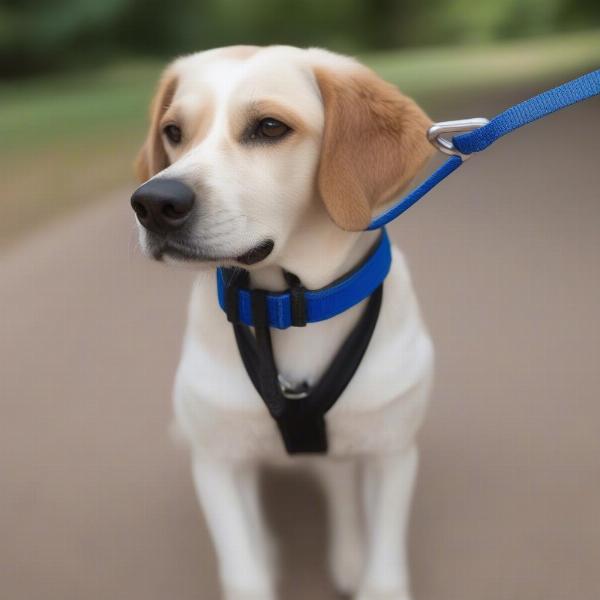The dog halter leash, often confused with a muzzle, offers a gentle yet effective way to manage your dog’s pulling behavior. This guide dives into everything you need to know about halter leashes, from how they work and their benefits to choosing the right one and training your dog to use it comfortably. We’ll explore various aspects, including different types of halters, fitting techniques, and addressing potential challenges.
How Does a Dog Halter Leash Work?
Unlike traditional collars that put pressure on the dog’s trachea, a dog halter leash works by gently guiding the dog’s head. It fits around the dog’s muzzle and connects to a leash, allowing you to redirect their attention and control their pulling. When the dog pulls, the halter gently turns their head towards you, discouraging the pulling behavior. This head-leading action provides more control, especially with strong or excitable dogs.
Benefits of Using a Dog Halter Leash
Dog halter leashes offer several advantages for both you and your dog:
- Reduced Pulling: The primary benefit is the significant reduction in pulling, making walks more enjoyable for everyone.
- Increased Control: Halter leashes offer better control, particularly with larger or stronger breeds.
- Improved Communication: By gently guiding your dog’s head, you can communicate your intentions more effectively.
- Enhanced Safety: A halter leash can prevent your dog from lunging at other dogs or people, improving safety in public spaces.
- Kinder to the Neck: Unlike collars that can strain the trachea, halter leashes distribute pressure more evenly across the head.
Choosing the Right Dog Halter Leash
Selecting the appropriate halter leash depends on your dog’s size, breed, and temperament.
- Size: Ensure the halter fits snugly but not too tight. A properly fitted halter should allow you to fit two fingers between the halter and your dog’s skin.
- Material: Opt for durable, comfortable materials like nylon or padded leather.
- Design: Consider different designs, such as those with adjustable straps or padded nosebands, for added comfort.
Training Your Dog to Use a Halter Leash
Introducing the halter leash gradually is key to a positive experience.
- Positive Association: Start by letting your dog sniff and investigate the halter. Reward them with treats and praise.
- Gradual Introduction: Put the halter on for short periods, gradually increasing the duration.
- Positive Reinforcement: Reward your dog for walking calmly while wearing the halter.
- Patience and Consistency: Be patient and consistent with your training. It may take time for your dog to adjust.
Addressing Potential Challenges
Some dogs may initially resist the halter leash.
- Rubbing: If the halter rubs against your dog’s face, ensure it’s fitted correctly and consider a padded noseband.
- Pawing: If your dog paws at the halter, distract them with treats and positive reinforcement.
- Escape Attempts: If your dog tries to remove the halter, ensure it’s securely fastened and continue positive reinforcement training.
 Dog wearing a halter leash correctly
Dog wearing a halter leash correctly
Conclusion
The dog halter leash is a valuable tool for managing pulling behavior and enhancing control during walks. By understanding how it works, choosing the right type, and implementing proper training techniques, you can transform your walks into enjoyable experiences for both you and your dog. Remember to prioritize your dog’s comfort and well-being throughout the process.
FAQ
- Is a dog halter leash the same as a muzzle? No, a halter leash guides the head, while a muzzle prevents biting.
- Can a halter leash hurt my dog? If fitted correctly and used properly, a halter leash should not cause pain.
- How do I choose the right size halter leash? Measure your dog’s muzzle circumference and refer to the manufacturer’s sizing chart.
- How long does it take to train a dog to use a halter leash? It varies, but with patience and consistency, most dogs adjust within a few days to a week.
- Can I use a halter leash on a puppy? Yes, but choose a puppy-sized halter and introduce it gently.
- What if my dog continues to pull even with the halter leash? Consult a professional dog trainer for personalized guidance.
- Are there any breeds that shouldn’t use a halter leash? Brachycephalic breeds (those with short noses) might require specialized halters or alternative solutions. Consult your veterinarian.
Related Articles on ILM Dog:
About ILM Dog
ILM Dog (ilmdog.com) is your comprehensive resource for expert advice on dog care and training. We offer practical guidance on breed selection, health, nutrition, grooming, and much more, catering to both new and experienced dog owners worldwide. Whether you’re seeking the perfect collar or need help with behavioral issues, ILM Dog provides reliable information and product recommendations to help you give your canine companion the best possible care. Contact us for personalized advice: Email: [email protected], Phone: +44 20-3965-8624.